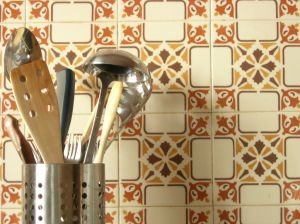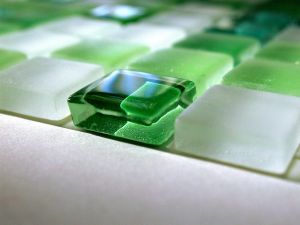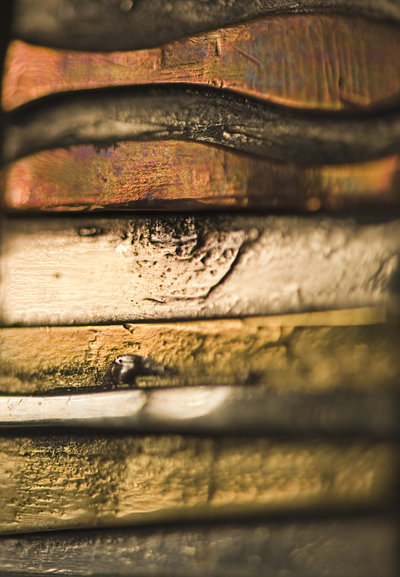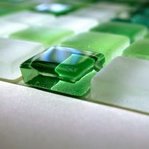 Marble? Glass? Stainless? Ceramic?
Marble? Glass? Stainless? Ceramic?
...there are so many options! The backsplash of your kitchen can be a great way to bring style and color to your kitchen renovation. From mosaics and glass, to stainless steel and wooden bead board, there are virtually unlimited options to choose from, tons of innovative new ideas and a wide variety of looks and colors. So what are the options? Pros and cons? Affordability?
Let’s take a look at some of the more common materials…
Stone or Solid Surface:
A popular choice has long been to simply extend the stone selected as the countertop up through the backsplash area. Using granite or marble slab as your backsplash can be rather expensive, but it is usually quite beautiful and extremely durable. Generally, you have to seal any natural stone or marble regularly as it is porous and will absorb anything that lands on its surface which can result in permanent stains. Using a quartz based countertop and backsplash, such as Silestone or Cambria, can be a good alternative to natural stone, as they are non-porous or may have anti-bacterial agents built into the stone. If you choose a solid surface product like Corian or Wilsonart for your countertops, the same material can be ordered in a thinner sheet size for the backsplash area, giving you a seamless look that is easy to clean and extremely durable.
Tile:
There are endless options available for tile backsplashes; from bright pops of porcelain color, simple white subway tile to extravagant metal or glass tiles, porcelain, slate or marble there are infinite combinations and varieties of tile to choose from. Glass tile has become much more popular due to its ease of maintenance and it being a recyclable, green choice. Mosaic tiles are small tiles made of any type of material, and usually attached to a sheet of mesh backing. They can be used as an accent or decorative insert  to accent a basic field tile or as the entire backsplash selection. Tile can be laid out in various patterns. Subway tile can be staggered, laid in a straight horizontal or on a vertical. It is important to plan it out so the tile fits nicely and you don’t have tiny pieces of cut tile everywhere, so be sure to take accurate measurements and consult with your installer or designer before ordering your tile. Tile can range in price from extremely affordable to extremely expensive, but it will give you plenty of options so you can choose what will fit into your projects budget.
to accent a basic field tile or as the entire backsplash selection. Tile can be laid out in various patterns. Subway tile can be staggered, laid in a straight horizontal or on a vertical. It is important to plan it out so the tile fits nicely and you don’t have tiny pieces of cut tile everywhere, so be sure to take accurate measurements and consult with your installer or designer before ordering your tile. Tile can range in price from extremely affordable to extremely expensive, but it will give you plenty of options so you can choose what will fit into your projects budget.
Metals:
Whether you like the look of old tin ceiling tiles, the clean, modern lines of stainless steel or metallic inserts in bronze, there are many metallic backsplash components to choose from. Stainless steel is a clean, polished look and pretty easy to maintain, but it can be expensive and must be templated and installed by a professional. Decorative tiles that look like stainless, bronze, gold or pewter are available at a variety of price points and can be easily incorporated into a backsplash or paired with a less expensive field tile. Of course, old tin ceiling tiles, reproductions or ceramic “look-alikes” are a beautiful choice for a backsplash and can also be very budget friendly as well.
 Any of these backsplash options can be used either by themselves or blended together. When choosing a backsplash keep in mind cleanability and how close it is to heavy food prep areas, exposure to water and heat from your appliances. Be careful to make appropriate selections accordingly. For instance, wooden beadboard should never meet directly with the countertop in any food prep or wet areas, and should not be used directly behind the cooktop area as both water and exposure to heat will damage it. A tip to achieve this look; Install a small 4” high piece of your countertop material right at the bottom of the backsplash area and use the beadboard from there up. You can also run the countertop material up the wall behind the cooktop area and use the beadboard on either side to avoid a fire hazard. Beadboard can be pretty inexpensive and pairs well with a vintage style kitchen. Be sure to properly coat it with paint or stain and seal it with polyurethane for a durable, washable finish.
Any of these backsplash options can be used either by themselves or blended together. When choosing a backsplash keep in mind cleanability and how close it is to heavy food prep areas, exposure to water and heat from your appliances. Be careful to make appropriate selections accordingly. For instance, wooden beadboard should never meet directly with the countertop in any food prep or wet areas, and should not be used directly behind the cooktop area as both water and exposure to heat will damage it. A tip to achieve this look; Install a small 4” high piece of your countertop material right at the bottom of the backsplash area and use the beadboard from there up. You can also run the countertop material up the wall behind the cooktop area and use the beadboard on either side to avoid a fire hazard. Beadboard can be pretty inexpensive and pairs well with a vintage style kitchen. Be sure to properly coat it with paint or stain and seal it with polyurethane for a durable, washable finish.
Most of all… have fun choosing your backsplash! This is where your personality can really shine through and where you can tie in colors, patterns or styles from adjacent rooms and the rest of your home and bring the whole project together. Some tile stores have designers available to consult with you and help you order the correct quantities. Be sure to bring along the dimensions of the backsplash areas, any windows that may be in that area, drawings of your cabinet layout, cabinetry color, color swatches for flooring and walls, and a countertop sample or photo if possible.
If you can’t decide which would be the best one for you, consult a professional kitchen and bath designer or an interior designer. They will help you stay within your budget, give you different layout options and help you pull together a look that you may never have thought of otherwise. The right backsplash choice can make or break your entire kitchen design. Choose wisely and be the envy of your neighborhood!












